Now & New
The Rebirth of the MOCA: Keeping Up with Our Time
Hiroshima City—not to mention the whole prefecture—has its fair share of museums to be found, and even among art museums alone, the types of museums span many movements in art history. One of the most famous in our city—the Museum of Contemporary Art (hereinafter referred to as MOCA) on top of Hijiyama Hill—had been undergoing renovations since 2020, and only reopened on the 18th of March, just in time for the start of Sakura Season. I am well aware that every museum needs to be refurbished every now and then, but as a museum of contemporary art, which is defined as “art of our time,” the MOCA needs that periodic modernization more than its counterparts. For you see, the MOCA building’s sleek design is a work of art in and of itself and amplifies the beauty of the surrounding Hijiyama Park. Thus, it has become a beloved landmark among the locals of our peaceful city, and although we got a bit antsy waiting for the museum to open back up, when the renovations ended, we were elated to know that the three years of patience were worth it in the end.
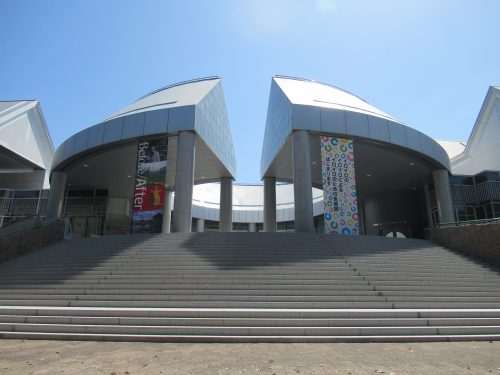
While I theoretically could have visited the MOCA on the first day it reopened (a Saturday at that), I decided it would be better to wait ten days before making the trip. The first reason was that a Tuesday was sure to be less crowded, and the second reason was that late March would be a more desirable time to check out the cherry blossoms spread out over Hijiyama Hill. From Hiroshima Station, one can easily access the MOCA by riding the Meipuru~pu Bus Orange Line from the Shinkansen Exit or riding the #5 streetcar to Hijiyama-shita Station (比治山下駅) and climbing Hijiyama Hill. If approaching from downtown like myself, Hijiyama Hill is less than a half-hour walk away from the east end of Hondori; I recommend walking east through Hijiyama Tunnel to ascend via the stairs and escalator of the Hijiyama Sky Walk for a more scenic journey.
It’s What’s on the Outside
At the top of the escalators, I was greeted by countless, fluffy cherry trees and the occasional abstract sculpture as I made my way towards the museum. Eventually, I reached the front entrance of the MOCA, and turned left to look upon Moore Plaza, one of the most popular locales in the city for sakura hanami parties. Picnic blankets, families, groups of friends, and work colleagues were strewn under the cherry blossoms, joined by an imposing green arch-shaped sculpture. According to a children’s T-shirt for sale inside the MOCA gift shop, the “Large Arch” inside Moore Plaza was erected here “in accordance with the wishes of Henry Moore and in the hope that all peoples may live in friendship and peace.”
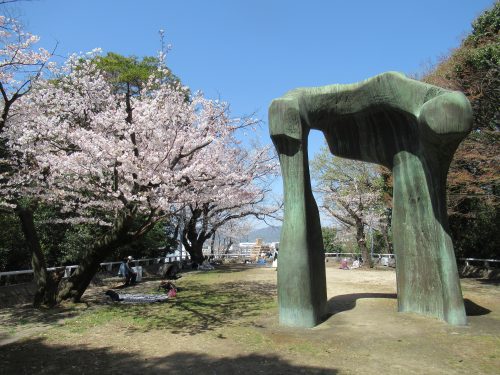
I took my sweet time gazing at the pinkish white flowers here and watching small children have a blast running around this vernal wonderland. Though the sakura and the Large Arch are mesmerizing, my favorite view here is the one I get when I walk to the edge and look out to the Kyobashi River below. Of course, the sakura added to the beauty of the landscape, but this view is gorgeous even past Sakura Season, and it’s even possible to see other flowers in the planters by the riverbank.
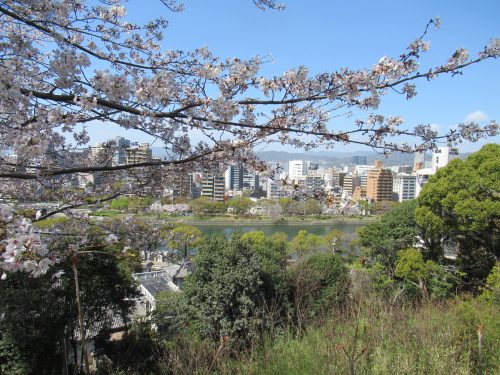
I then made my way toward the MOCA, but rather than enter straight away, I walked around the perimeter of the building and checked out the other sculptures on display outside. All the pieces I remember from before the renovations began were still in this area, such as the fat bird with a highly-apparent cloaca at the rear end, as well as the array of weird statues seemingly resembling human brains. These sculptures were all in proximity of the café’s outdoor patio seating, which made me want to grab lunch immediately, but I opted to enter from inside the museum after perusing the gift shop.

Foodie’s Dream
At the entrance to the gift shop was a sign informing visitors that the wearing of masks was now up to the discretion of the individual, but alas, I have grown too accustomed to keeping my mask on in public. Inside the shop was a plethora of locally-produced souvenirs, including snacks and condiments to be enjoyed at home. Being that Hiroshima is an “oyster prefecture,” several of the souvenirs were oyster-themed, including this cute tote bag and these keychains that could be mistaken for fried oysters from a distance. The stuffed oysters come with a pearl, and are even packaged in the same manner as fried oysters we buy at supermarkets.
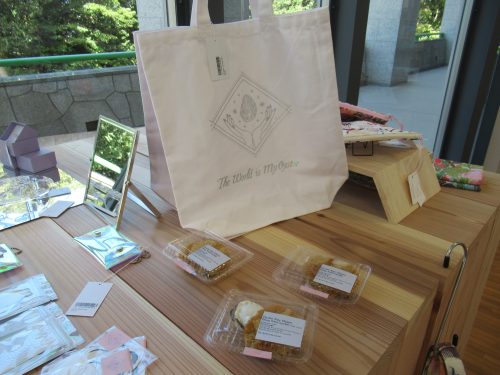
Seeing the fake food in the gift shop was making me hungry for some real food, so into the café I went, and thankfully, it was not at all a long wait for me to be seated. The staff were all so polite and attentive while serving me my water and explaining the menu. The menu book was long, but actually only had a short range of food options backed by comprehensive descriptions and backstories of the local establishments that provide the bread, wine, et cetera.
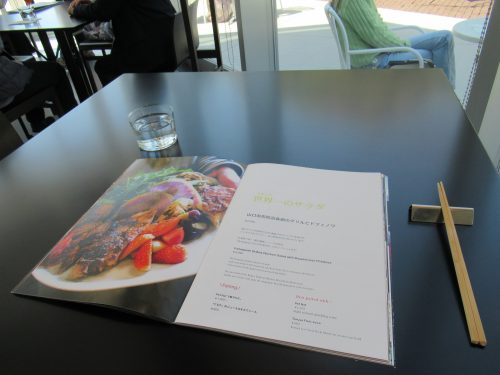
I took forever and a day pondering what to order because every single meal looked appetizing and worth every yen. At long last, I went with the grilled chicken salad served with rustic bread and a potato gratin dauphinois. The chicken is from Suo Takamori in Yamaguchi Prefecture, the seasoning salt from Oda in Shimane Prefecture, the herbs from Kajiya Farm in Mihara, Hiroshima Prefecture, and the bread from Boulangerie Chez Georges in Saijo, Hiroshima Prefecture. After ordering, I took the time to read the description of Boulangerie Chez Georges inside the menu book, which described the bakery as striving to bake bread and other goods that friends and family happily share at the dinner table with food and wine, with an aroma so tantalizing that customers may inadvertently take a bite out of them before going back home. The menu takes pride in their ingredients, all of which are seasonal and sourced from local farms and businesses in Hiroshima or nearby prefectures, so I knew I was in for a treat when my order finally came.
Moment of Joy: Farm to Table

I usually expect museum entrées to be on the petit side, so this humongous platter of chicken, vegetables, fruit, potatoes, and bread blew my mind! The chicken was succulent and well-seasoned, the salad undeniably fresh and sufficiently dressed in oil, the potatoes au gratin creamy and melt-in-your-mouth delicate, and the bread that perfect combination of having a crispy outer crust with a fluffy interior. Every ingredient of this lunch was the freshest version of it I had ever tasted, to the point where I felt like I was eating straight from Mother Nature herself. The stellar service before, during, and after the meal was the proverbial cherry on top that unquestionably made this moment the highlight of my day.
It’s What’s on the Inside
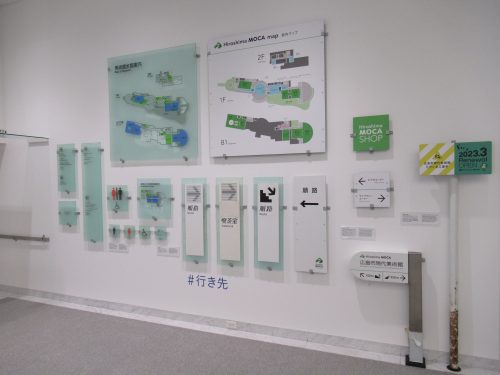
With a bloated belly and high spirits, I was ready to tackle the main objective: the revamped exhibit halls. Upon entering the first room, I was greeted by old building parts that belonged to previous incarnations of the MOCA. They had old signage, fluorescent track lighting, and even functioning elevator buttons, all of which visitors were invited to touch (the fluorescent lights have some sharp edges, so caution is advised). If you ever wanted to press the emergency call button in an elevator without getting into trouble, the time is now, and the place is here!
In the same room were a model of the MOCA when it was first built, as well as pictures, a video with drone footage, free flyers to take home, and other memorabilia relating to the most recent renovation project. One can tell by the sheer number of photographs of the ongoing works, the sign counting down the days to completion, and the drone flyovers comparing the building before, in the middle of, and after refurbishment that everyone involved was fervent about delivering the best version possible of the MOCA to the people of Hiroshima. I didn’t swing by Hijiyama at any point during the period of the project, so I was delighted to be able to pretend to be a part of the MOCA’s history by taking home a flyer even after the fact.

The next room was dedicated to two Japanese artists residing in Taipei who decided to engage in a video project involving the manipulation of everyday objects. Replicas of said objects featured in the numerous videos were lain about in an orderly fashion, alongside several television monitors showing the videos in question. The videos were nonverbal and quite boring for the most part, showing the artists using the objects as normal or dropping, throwing, kicking, or knocking them over. There were some moments that got a chuckle out of me or had me ask “why?” such as having two spray bottles spray at each other or having an electric fan make a vortex out of toilet paper.
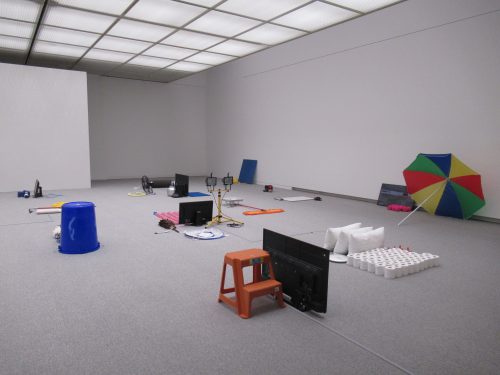
I went downstairs into a dimly-lit room showing even more abstract stuff, some of which I was not allowed to photograph, but they were selective and arbitrarily flexible about what I could capture. For instance, the dog sculptures could be photographed but not the iron silo, but the museum employee informed me that the silo could make a cameo in a photo of the dogs so long as I wasn’t aiming my camera at the silo itself. Elsewhere in the same room were an interactive video project, sculptures involving a real carrot, cases containing furniture covered with a layer of material that glowed in the dark, and paintings by the famous Yoko Ono (naturally, pictures of those were forbidden).
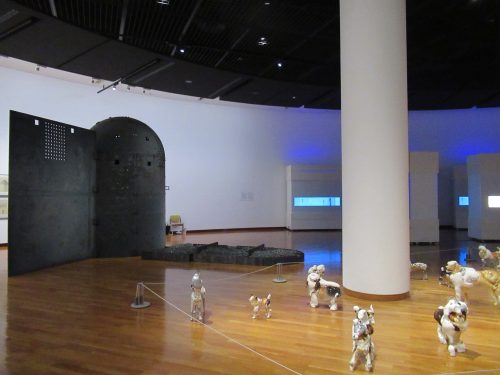
From here, I climbed up the stairs to the area behind the ticket counter, where there was a small section explaining the literary sources for the fonts used on the numbers for the lockers in the coin locker room. It would appear that they went all-out with their aesthetic renovations, even brushing up on details in places most visitors would overlook. However, the exhibit didn’t end here, as there was a second hall on the other end of the building that I had yet to explore. Oddly enough, it was only in front of the second hall that they started checking for tickets, and during busy hours it’s possible to unknowingly walk past the table without flashing proof of admission.
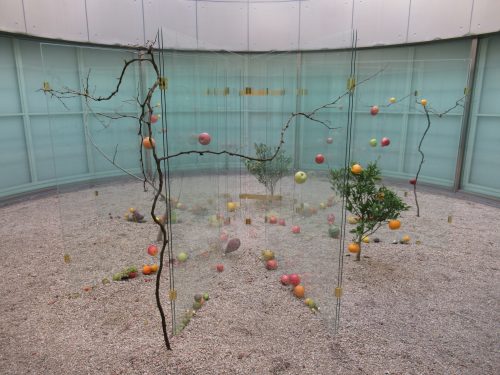
The majority of the works in this second hall were either not allowed to be photographed or wouldn’t look good on camera anyway, so the only meaningful memory I captured here was this display in the miniature courtyard of real fruit sandwiched between panes of glass. On the inside were paintings and sketches of countless themes, and even more video artworks, including a YouTube Poop-esque project using an old Wonder Woman series, a short film about a mushroom conversing with an old fortress wall about decomposition versus preservation, and a video interview with a woman whose home was lost in the 2011 Tohoku earthquake and ensuing tsunami. Honestly, there was a lot that I would’ve wanted to take pictures or videos, but let’s face it: recording video of videos would look downright tacky and possibly illegal.
The MOCA’s Reach
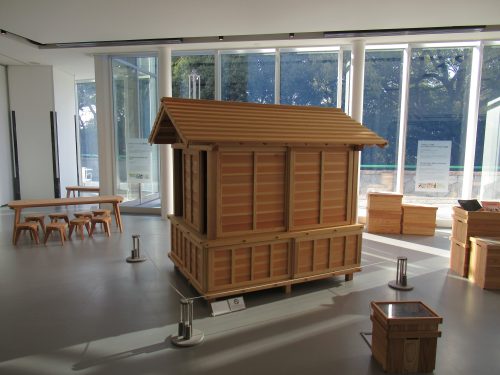
After finishing the latter half of my museum tour, but before leaving the building, I caught sight of a structure resembling a wooden ark in a room by the café. This gargantuan container was constructed by the designer duo “2m26,” which consists of Mélanie Heresbach and Sébastien Renauld, and was dubbed “Toolbox,” as it was a moveable workshop station that contained tables, stools, and tools for people to work basically anywhere. “Toolbox” was utilized during the MOCA’s closure in order to reach out to the community, and blurred the lines between indoors and outdoors by holding craft workshops in places like the grassy areas of Peace Boulevard. Participants feel a heightened sense of camaraderie and connection to Hiroshima when gathered at these tables making paper crafts, drinking tea, and playing together, and even after the reopening of the MOCA, events involving “Toolbox” continue to be held from time to time.
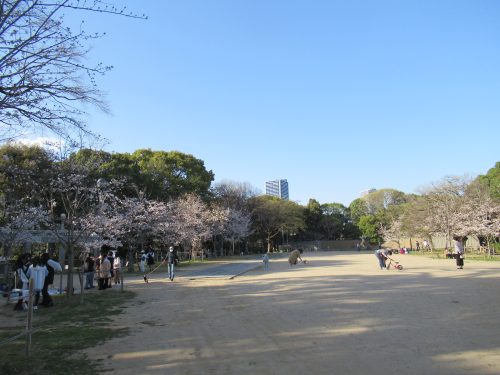
The appeal of the MOCA extends well beyond its walls, because those who visit the MOCA will also take the time to enjoy Moore Plaza, the adjacent Manga Library, which has a park of its own. This park was also rife with children, families, and locals with their pets playing, admiring the sakura, and basking in the warm sunshine. A final walk through the nature of Hijiyama Hill provided a proper closing to my visit to the new MOCA, which, like the cherry blossoms, bloomed fabulously to welcome the start of a new year.

This was by no means my first visit to the MOCA, but I can say with certainty that the reborn museum was the best version I have seen thus far. What’s more is that they continued to involve so many people during the renovation period, which raised interest in the MOCA’s revival and in turn enhanced the artworks of the initial exhibit. As can be seen in so many parts of Japan, construction work on tourist sites like these lets these places evolve with the waves of tourists and benefits municipalities as a whole. Though most would visit Hiroshima for its history under feudalism or during World War II, the keenest of the history buffs would also gain much from a trip to the new MOCA in order to grasp the “history of our time.”
Written by the Joy in Hiroshima Team
